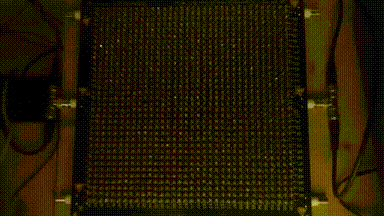神经雪崩
此词条由神经动力学读书会词条梳理志愿者Spidey0o0Zheng翻译审校,未经专家审核,带来阅读不便,请见谅。
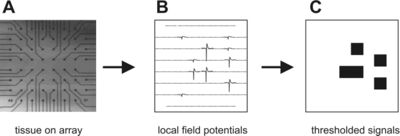
神经雪崩 is a cascade of bursts of activity in neuronal networks whose size distribution can be approximated by a power law, as in critical sandpile models (Bak et al. 1987). Neuronal avalanches are seen in cultured and acute cortical slices (Beggs and Plenz, 2003; 2004). Activity in these slices of neocortex is characterized by brief bursts lasting tens of milliseconds, separated by periods of quiescence lasting several seconds. When observed with a multielectrode array, the number of electrodes driven over threshold during a burst is distributed approximately like a power law. Although this phenomenon is highly robust and reproducible, its relation to physiological processes in the intact brain is currently not known.
实验观察 Experimental Observations

幂律尺寸分布 Power law size distribution
The movie illustrates that multi-channel data can be broken down into frames where there is no activity and where there is at least one active electrode, which may pick up the activity from several neurons. A sequence of consecutively active frames, bracketed by inactive frames, can be called an avalanche. The example avalanche shown has a size of 9 because this is the total number of electrodes that were driven over threshold. Avalanche sizes are distributed in a manner that is nearly fit by a power law. Due to the limited number of electrodes in the array, the power law begins to bend downward in a cutoff well before the array size of 60. But for larger electrode arrays, the power law is seen to extend much further.
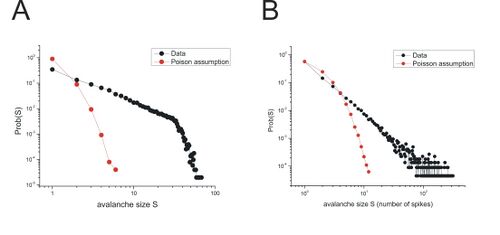
The equation of a power law is:
- [math]\displaystyle{ P(S)=kS^{-\alpha}\, }[/math]
where [math]\displaystyle{ P(S) }[/math] is the probability of observing an avalanche of size [math]\displaystyle{ S\ , }[/math] [math]\displaystyle{ \alpha }[/math] is the exponent that gives the slope of the power law in a log-log graph, and [math]\displaystyle{ k }[/math] is a proportionality constant. For experiments with slice cultures, the size distribution of avalanches of local field potentials has an exponent [math]\displaystyle{ \alpha\approx 1.5\ , }[/math] but in recordings of spikes from a different array the exponent is [math]\displaystyle{ \alpha\approx2.1\ . }[/math] The reasons behind this difference in exponents are still being explored. It is important to note that a power law distribution is not what would be expected if activity at each electrode were driven independently. An ensemble of uncoupled, Poisson-like processes would lead to an exponential distribution of event sizes. Further, while power laws have been reported for many years in neuroscience in the temporal correlations of single time-series data (e.g., the power spectrum from EEG (Linkenkaer-Hansen et al, 2001; Worrell et al, 2002), Fano or Allan factors in spike count statistics (Teich et al, 1997), neurotransmitter secretion times (Lowen et al, 1997), ion channel fluctuations (Toib et al, 1998), interburst intervals in neuronal cultures (Segev et al, 2002)), they had not been observed from interactions seen in multielectrode data. Thus neuronal avalanches emerge from collective processes in a distributed network.
重复的雪崩模式 Repeating avalanche patterns
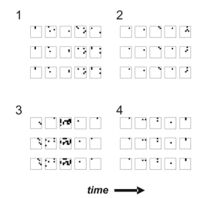
While avalanches in critical sandpile models are stochastic in the patterns they form, avalanches of local field potentials occur in spatio-temporal patterns that repeat more often than expected by chance (Beggs and Plenz, 2004). The figure shows several such patterns from an acute cortical slice. These patterns are reproducible over periods of as long as 10 hours, and have a temporal precision of 4 ms (Beggs and Plenz, 2004). The stability and precision of these patterns suggest that neuronal avalanches could be used by neural networks as a substrate for storing information. In this sense, avalanches appear to be similar to sequences of action potentials observed in vivo while animals perform cognitive tasks. It is unclear at present whether the repeating activity patterns from in vivo data are also avalanches. 临界沙堆模型中的雪崩在其形成的模式中是随机的,与之相比,局部场电位的雪崩发生的时空模式比预期的偶然性更频繁(Beggs和Plenz,2004)。图中显示了一个急性皮层切片的几个这样的模式。这些模式在长达10个小时的时间内是可重复的,其时间精度为4ms(Beggs和Plenz,2004)。这些模式的稳定性和精确性表明,神经雪崩可以被神经网络用作存储信息的基底。在这个意义上,雪崩似乎与在动物执行认知任务时在体内观察到的动作电位序列相似。目前还不清楚体内数据的重复活动模式是否也是雪崩。
Generality
In the above example, avalanches are produced in cortical slice cultures bathed in culture medium, but it is also possible to produce avalanches in acute cortical slices when they are bathed in artificial cerebrospinal fluid with dopamine agonists and NMDA (Beggs and Plenz, 2003; Stewart and Plenz, 2006), or with high K+ and low Mg++. The different ways of inducing avalanches suggests that they are not particular to only one set of experimental conditions.
Preliminary Reports in Other Systems
Power law distributions of sequence sizes have also been observed in spikes from the isolated leech ganglion (V. Torre, conference talk) and in spikes from dissociated cortical cultures (L. Bettencourt; R. Alessio, personal communications), suggesting that the phenomenon of avalanches may be quite general to in-vitro preparations. Preliminary reports also indicate that avalanches are present in the superficial cortical layers of awake, resting primates (Petermann et al, 2006). These reports have not been published yet and are included here only to indicate that researchers are now exploring the avalanche concept in a variety of preparations.
雪崩模型 Models of avalanches
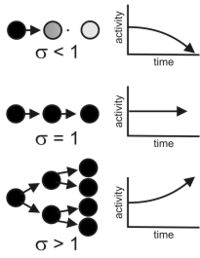
Models that explicitly predicted avalanches of neural activity include the work of Herz and Hopfield (1995) which connects the reverberations in a neural network to the power law distribution of earthquake sizes. Also notable is the work of Eurich, Hermann and Ernst (2002), which predicted that the avalanche size distribution from a network of globally coupled nonlinear threshold elements should have an exponent of [math]\displaystyle{ \alpha=1.5\ . }[/math] Remarkably, this exponent turned out to match that reported experimentally (Beggs and Plenz, 2003).
A branching process model is described here in more detail (Harris, 1989; Beggs and Plenz, 2003; Haldeman and Beggs, 2005; reviewed in Vogels et al, 2005), because it captures both the power law distribution of avalanche sizes and the reproducible activity sequences observed in the data. In this model, a processing unit which is active at one time step will produce, on average, activity in [math]\displaystyle{ \sigma }[/math] processing units in the next time step. The number [math]\displaystyle{ \sigma }[/math] is called the branching parameter and can be thought of as the expected value of this ratio:
- [math]\displaystyle{ \sigma=\frac{\mbox{Descendants}}{\mbox{Ancestors}} }[/math]
where Ancestors is the number of processing units active at time step t and Descendants is the number of processing units active at time step t + 1. There are three general regimes for [math]\displaystyle{ \sigma\ , }[/math] as shown in the figure.
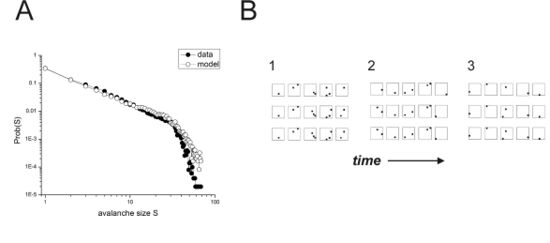
At the level of a single processing unit in the network, the branching parameter [math]\displaystyle{ \sigma }[/math] is set by the following relationship:
- [math]\displaystyle{ \sigma_i=\sum_{j=1}^\mathit{N} \mathit{p_{ij}} }[/math]
where [math]\displaystyle{ \sigma_i }[/math] is the expected number of descendant processing units activated by unit [math]\displaystyle{ i\ , }[/math] [math]\displaystyle{ N }[/math] is the number of units that unit [math]\displaystyle{ i }[/math] connects to, and [math]\displaystyle{ p_{ij} }[/math] is the probability that activity in unit [math]\displaystyle{ i }[/math] will transmit to unit [math]\displaystyle{ j\ . }[/math] Because some transmission probabilities are greater than others, preferred paths of transmission may occur, leading to reproducible avalanche patterns. Both the power law distribution of avalanche sizes and the repeating avalanches are qualitatively captured by this model when [math]\displaystyle{ \sigma }[/math] is tuned to the critical point ([math]\displaystyle{ \sigma=1 }[/math]), as shown in the figure (Haldeman and Beggs, 2005). When the model is tuned moderately above ([math]\displaystyle{ \sigma\gt 1 }[/math]) or below ([math]\displaystyle{ \sigma\lt 1 }[/math]) the critical point, it fails to produce a power law distribution of avalanche sizes. This phenomenological model does not explicitly state the cellular or synaptic mechanisms that may underlie the branching process, and many of this model's predictions need to be tested.
雪崩的含义 Implications of avalanches
When a tunable system operates in a regime where it produces power law distributions, it is said to be operating at the critical point. Strictly speaking, only infinitely large systems can operate at the critical point, but here the term “critical” is used to describe behavior in finite systems that would approach criticality if they were extended to unlimited sizes. The power law avalanche size distribution has potential implications for information processing in neural networks in these four areas:
- Information transmission. When neural networks are tuned to the critical point, they have optimal information transmission (Beggs and Plenz, 2003; Bertschinger and Natschlager, 2004; Kinouchi and Copelli, 2006), because there is a balance between strong signal propagation and resistance to saturation.
- Information storage. When a recurrent network based on a branching process is tuned to the critical point, the number of significantly repeating avalanche patterns is maximized (Haldeman and Beggs, 2005). At the critical point, there is a mixture of strong and weak connections, allowing for a variety of independently stable patterns of activity.
- Computational power. By changing the variance in synaptic weights in a spiking network model, Bertschinger and Natschlager (Bertschinger and Natschlager 2004) were able to produce networks that showed damped, sustained, and expanding activity. These regimes correspond to subcritical, critical, and supercritical dynamics respectively. They found that networks tuned to the critical point performed more effectively on a broad range of computational tasks than networks that were tuned to have either subcritical or supercritical dynamics.
- Stability. When a recurrent, branching network model is tuned to the critical point, it produces largely parallel trajectories, meaning that the network is at the edge of stability (Bertschinger and Natschlager, 2004; Haldeman and Beggs, 2005). In this case, trajectories are still stable and yet are controllable with minor corrective inputs.
Optimizing all of these information processing tasks may occur simultaneously when a network operates near the critical point, where neuronal avalanches occur.
神经雪崩与其他系统的关系 Relationship of neuronal avalanches to other systems
Power law distributions of event sizes are often seen in complex phenomena including earthquakes, phase transitions, percolation, forest fires, financial market fluctuations, avalanches in the game of life and a host of others (Bak, 1996). In some specific cases, this similarity appears to be more than superficial. For example, earthquake models incorporate local rules in which forces at one site are distributed to nearest neighbors without dissipation. This conservation of forces is similar to the conservation of probabilities in the critical branching model described above. This suggests that conservation of synaptic strengths, as reported in (Royer and Pare, 2003) could be a mechanism responsible for maintaining a network near the critical point. In a related idea, simulations indicate that networks can be kept nearly critical when the total sum of synaptic strengths hovers near a constant value (Hsu and Beggs, 2006). This could be accomplished through a mechanism like synaptic scaling (Turrigiano and Nelson, 2000), which has been observed experimentally. Finally, recently "burned" areas in forest fire models are refractory, while unburned areas are more likely to ignite. This balance of refractoriness and excitability combine to maintain the system near the critical point. Recent models of neuronal avalanches (Levina, Herrmann and Geisel, 2005) have suggested that short-term synaptic depression and facilitation may also serve to drive neuronal networks toward the critical point where avalanches occur. Thus, an understanding of power laws in diverse complex systems can suggest mechanisms that might underlie criticality in neuronal networks.
A simple electronic model of avalanche generation consists of a two-dimensional array of neon lamps, each one connected to a resistor towards a global DC control voltage and capacitively coupled to its von Neumann neighbors. Neon lamps possess rich dynamical properties: as the applied voltage changes, the transition between the "on" and "off" phases is at the same time significantly hysteretic and stochastic (Dance, 1968). The system displays two phases, [math]\displaystyle{ I }[/math] and [math]\displaystyle{ II }[/math], respectively characterized by low and high event rate and spatiotemporal order: the transition between them is strongly hysteretic, hence unequivocally first-order. Nevertheless, close to the spinal point of the [math]\displaystyle{ I\rightarrow II }[/math] transition, critical precursors emerge in the form of avalanches (Fig. 8) having the same scaling exponents characterizing neural activity, namely [math]\displaystyle{ \alpha\approx3/2 }[/math] for size and [math]\displaystyle{ \alpha\approx2 }[/math] for duration (Minati et al., 2016).
External Links and Acknowledgements
The writing of this work and the experiments presented in the figures were funded by the National Science Foundation, grant number 0343636 to John Beggs, and by Indiana University. The initial work on neuronal avalanches was done in the laboratory of Dietmar Plenz, and was funded by the intramural research program of the National Institutes of Health.
参考文献 References
- Bak, P. (1996). How nature works: the science of self-organized criticality. New York, NY, USA, Copernicus.
- Bak P, Tang C, Wiesenfeld K (1987). Self-organized criticality: an explanation of the 1/f noise. Phys Rev Lett 59:381–384.
- Beggs, J. M. and D. Plenz (2003). Neuronal avalanches in neocortical circuits. J Neurosci 23(35): 11167-77.
- Beggs, J. M. and D. Plenz (2004). Neuronal avalanches are diverse and precise activity patterns that are stable for many hours in cortical slice cultures. J Neurosci 24(22): 5216-29.
- Bertschinger, N. and T. Natschlager (2004). "Real-time computation at the edge of chaos in recurrent neural networks." Neural Comput 16(7): 1413-36.
- Dance J. N. (1968). "Cold Cathode Tubes." Iliffe, London, UK.
- Eurich CW, Herrmann JM, Ernst UA (2002). Finite-size effects of avalanche dynamics. Phys Rev E Stat Nonlin Soft Matter Phys 66:066137.
- Haldeman, C, Beggs, JM (2005). Critical branching captures activity in living neural networks and maximizes the number of metastable states. Phys Rev Lett, 94: 058101.
- Harris TE (1989). The theory of branching processes. New York: Dover.
- Herz AV, Hopfield JJ (1995). Earthquake cycles and neural reverberations: collective oscillations in systems with pulse-coupled threshold elements. Phys Rev Lett 75:1222–1225.
- Hsu D, Beggs JM (2006). Neuronal avalanches and criticality: A dynamical model for homeostasis. Neurocomputing 69(1134-1136).
- Kinouchi O, Copelli M (2006). Optimal dynamic range of excitable networks at criticality. Nature Physics 2:348-351.
- Levina A, Herrmann JM, Geisel T (2005). Dynamical synapses give rise to a power law distribution of neuronal avalanches. Neural Information Processing Systems (NIPS) http://books.nips.cc/papers/files/nips18/NIPS2005_0646.pdf
- Linkenkaer-Hansen K, Nikouline VV, Palva JM, Ilmoniemi RJ (2001). Long-range temporal correlations and scaling behavior in human brain oscillations. J Neurosci 21:1370–1377.
- Lowen SB, Cash SS, Poo MM, Teich MC (1997). Quantal neurotransmitter secretion rate exhibits fractal behavior. J Neurosci 17:5666–5677.
- Minati, L; de Candia, A; Scarpetta, S. "Critical phenomena at a first-order phase transition in a lattice of glow lamps: Experimental findings and analogy to neural activity". Chaos. 26: 073103. doi:10.1063/1.4954879.
- Petermann T, Lebedev M, Nicolelis M, Plenz D (2006). Neuronal avalanches in vivo. Society for Neuroscience Abstracts.
- Royer S, Pare D (2003). Conservation of total synaptic weight through balanced synaptic depression and potentiation. Nature 422(6931):518-22.
- Segev R, Benveniste M, Hulata E, Cohen N, Palevski A, Kapon E, Shapira Y, Ben Jacob E (2002). Long term behavior of lithographically prepared in vitro neuronal networks. Phys Rev Lett 88:118102.
- Stewart CV, Plenz D (2006). Inverted-U profile of dopamine-NMDA-mediated spontaneous avalanche recurrence in superficial layers of rat prefrontal cortex. J Neurosci. 2006 Aug 2;26(31):8148-59.
- Teich MC, Heneghan C, Lowen SB, Ozaki T, Kaplan E (1997). Fractal character of the neural spike train in the visual system of the cat. J Opt Soc Am A Opt Image Sci Vis. 1997 Mar;14(3):529-46.
- Toib A, Lyakhov V, Marom S (1998). Interaction between duration of activity and time course of recovery from slow inactivation in mammalian brain Na_ channels. J Neurosci 18:1893–1903.
- Torre V (2006) Talk at NeuroIT conference in Genoa, Italy: http://www.neuroengineering.it/download/20.Torre.pdf
- Turrigiano GG, and Nelson SB (2000). Hebb and homeostasis in neuronal plasticity. Curr Opin Neurobiol 10:358-364.
- Vogels, T. P., K. Rajan and L. F. Abbott (2005). Neural network dynamics. Annu Rev Neurosci 28: 357-76.
- Worrell GA, Cranstoun SD, Echauz J, Litt B (2002). Evidence for self-organized criticality in human epileptic hippocampus. NeuroReport 13:2017–2021.
Internal references
- Valentino Braitenberg (2007) Brain. Scholarpedia, 2(11):2918.
- Eugene M. Izhikevich (2006) Bursting. Scholarpedia, 1(3):1300.
- Olaf Sporns (2007) Complexity. Scholarpedia, 2(10):1623.
- Gregoire Nicolis and Catherine Rouvas-Nicolis (2007) Complex systems. Scholarpedia, 2(11):1473.
- James Meiss (2007) Dynamical systems. Scholarpedia, 2(2):1629.
- Paul L. Nunez and Ramesh Srinivasan (2007) Electroencephalogram. Scholarpedia, 2(2):1348.
- Robert Kozma (2007) Neuropercolation. Scholarpedia, 2(8):1360.
- Philip Holmes and Eric T. Shea-Brown (2006) Stability. Scholarpedia, 1(10):1838.
See also
Avalanches, Complexity, Complex Systems, Game of Life, Neuropercolation, Self-organized criticality, Statistical Mechanics of Neocortex

